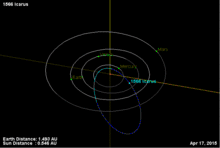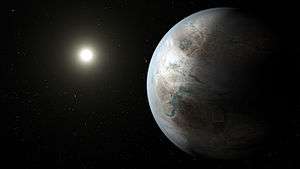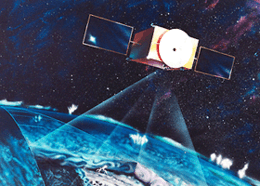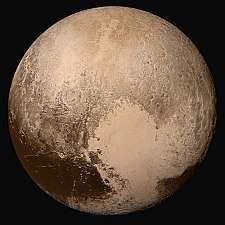1566 Icarus
| Discovery [1] | |
|---|---|
| Discovered by | W. Baade |
| Discovery site | Palomar Obs. |
| Discovery date | 27 June 1949 |
| Designations | |
| MPC designation | (1566) Icarus |
| Pronunciation | /ˈɪkərəs/ IK-ə-rəs |
Named after | Icarus [2] (Greek mythology) |
| 1949 MA | |
|
NEO · Apollo · PHA [1][3] Mercury-, Venus-, and Mars-crosser | |
| Orbital characteristics [1] | |
| Epoch 23 March 2005 (JD 2453452.5) | |
| Uncertainty parameter 0 | |
| Observation arc | 66.08 yr (24,136 days) |
| Aphelion | 1.9692 AU |
| Perihelion | 0.1867 AU |
| 1.0779 AU | |
| Eccentricity | 0.8268 |
| 1.12 yr (409 days) | |
| 346.35° | |
| 0° 52m 50.52s / day | |
| Inclination | 22.852° |
| 88.082° | |
| 31.297° | |
| Earth MOID | 0.0352 AU · 13.7 LD |
| Physical characteristics | |
| Dimensions | (1.61 × 1.60 × 1.17) km[4] |
Mean diameter |
1.0 km[lower-alpha 1] 1.03±0.04 km[5] 1.27 km[6] 1.417±0.123 km[7] 1.44±0.26 km[4] |
|
2.268 h[8] 2.27±0.05 h[9] 2.2726±0.0003 h[10] 2.273 h[11] 2.27364 h[12] 2.2794±0.0005 h[13] | |
|
0.14[4] 0.14±0.10[14] 0.199±0.110[7] 0.29±0.05[5] 0.33[6] 0.40[15] 0.51[lower-alpha 1] | |
|
S [16] · S/Q[17] B–V = 0.774 [1] U–B = 0.520 [1] | |
| 16.3[6] · 16.3±0.3[7] · 16.6[11] · 16.9[1][5] · 16.96[4][16] | |
|
| |
1566 Icarus (/ˈɪkərəs/ IK-ə-rəs), provisional designation 1949 MA, is an extremely eccentric asteroid, approximately 1.4 kilometers in diameter. It is a near-Earth object of the Apollo group and the lowest numbered potentially hazardous asteroid.[18] In 1968, it became the first asteroid ever observed by radar.[2] Its orbit brings it closer to the Sun than Mercury and further out than the orbit of Mars, which also makes it a Mercury-, Venus-, and Mars-crosser. This stony asteroid and relatively fast rotator was discovered by German astronomer Walter Baade at the Palomar Observatory, California, on 27 June 1949.[3] It was named after the mythological boy Icarus, who flew too close to the Sun.[2]
Orbit and classification

Icarus orbits the Sun at a distance of 0.2–2.0 AU once every 1 years and 1 month (409 days). Its orbit has an eccentricity of 0.83 and an inclination of 23° with respect to the ecliptic.[1] The body's observation arc begins with its official discovery observation at Palomar.[3]
At perihelion, Icarus comes closer to the Sun than Mercury, i.e. it is a Mercury-crossing asteroid. It is also a Venus and Mars-crosser. From 1949 until the discovery of 3200 Phaethon in 1983, it was known as the asteroid that passed closest to the Sun. Since then hundreds of Mercury-crossers have been found, the closest ones are now being 2005 HC4 and (394130) 2006 HY51 (also see List of Mercury-crossing minor planets § List).
Meteor shower
Icarus is thought to be the source of the Arietids,[19] a strong daylight meteor shower. However other objects such as the short-period sun-grazing comet 96P/Machholz are also possible candidates for the shower's origin.[20]
Close approaches
Icarus has an Earth minimum orbital intersection distance of 0.0352 AU (5,270,000 km), which translates into 13.7 lunar distances (LD).[1] This near-Earth object and potentially hazardous asteroid makes close approaches to Earth in June at intervals of 9, 19, or 28 years.
In 14 June 1968, it came as close as 0.042482 AU (6,355,200 km), or 16 LD.[21] During this approach, Icarus became the first minor planet to be observed using radar, with measurements obtained at the Haystack Observatory[22] and the Goldstone Tracking Station.[23]
The last close approach was on 16 June 2015, when Icarus passed Earth at 0.05383 AU (8,053,000 km) or 22 LD.[4][21] Before that, the previous close approach was on 11 June 1996, at 0.10119 AU (15,138,000 km), almost 40 times as far as the Moon. The next notably close approach will be on 13 June 2043, at 0.0586 AU (8,770,000 km) from Earth.[21]
Physical characteristics
Radiometric observation characterized Icarus as a stony S-type and Q-type asteroid.[17]
Rotation period
Since 1968, several rotational lightcurves of Icarus were obtained from photometric and radiometric observations.[8][11][12] During the asteroid's close approach in June 2017, observations of the fast-moving object were taken by Italian astronomers Virginio Oldani and Federico Manzini, Brian Warner at the Palmer Divide Station (U82) in California, and by Australian astronomers at the Darling Range and Blue Mountains Observatories (Q68).[9][10][13][lower-alpha 2]
Lightcurve analysis gave it a consolidated rotation period of 2.2726 hours with a brightness variation of 0.22 magnitude (U=3).[16][lower-alpha 2] Icarus is a relatively fast rotator, near the threshold where non-solid rubble piles fly apart.
Spin axis
In 2015, radiometric observations at the Goldstone Observatory in California found a spin axis of (270.0°, −81.0°) in ecliptic coordinates (λ, β).[4]
Diameter and albedo
According to several radiometric and photometric observations, including the survey carried out by the NEOWISE mission of NASA's Wide-field Infrared Survey Explorer, Icarus measures between 1.0 and 1.44 kilometers in diameter and its surface has an albedo between 0.14 and 0.51.[5][6][7][4][14][lower-alpha 1]
The Collaborative Asteroid Lightcurve Link adopts the radiometric results obtained at Goldstone Observatory in June 2015, which gave an albedo of 0.14 and a diameter of 1.44 kilometers based on an absolute magnitude of 16.96.[16] Goldstone observations also gave the body's dimensions: 1.61 × 1.60 × 1.17 kilometers.[4]
Naming
This minor planet was named after Icarus, son of Daedalus (also see 1864 Daedalus) from Greek mythology. They attempted to escape prison by means of wings constructed from feathers and wax. Icarus ignored his father's instructions not to fly too close to the Sun. When the wax in his wings melted he fell into the sea and drowned.[2] The naming was suggested by R. C. Cameron and Dr. Folkman. The official naming citation was published by the Minor Planet Center before November 1977 (M.P.C. 347).[24] Both mythological figures are honored with the lunar craters Icarus and Daedalus.[2]
Research interests
Icarus is being studied to better understand general relativity, solar oblateness, and Yarkovsky drift.[25] Perihelion precession, caused by general relativity, in the case of Icarus is 10.05 arcseconds per Julian century.[25]
Project Icarus
"Project Icarus" was a student project conducted at MIT in the spring of 1967, to defend against risks from 1566 Icarus.
This project was an assignment by Paul Sandorff for his group of Massachusetts Institute of Technology graduate students in a systems engineering class to devise a plan to use rockets to deflect or destroy Icarus in the case that it was found to be on a collision course with planet Earth.[26][27][28] Time magazine ran an article on the endeavor in June 1967[27] and the following year the student report was published as a book.[26][28][29]
In the course of their study the students visited the Kennedy Space Center, Florida, where they were so impressed with the Vertical Assembly Building that they wrote of "the awesome reality" that had "completely erased" their doubts over using the technology associated with the Apollo program and Saturn rockets.[30]
In fiction
The report later served as the basis and inspiration for the 1979 science fiction film Meteor.[28][31]
Notes
References
- 1 2 3 4 5 6 7 8 "JPL Small-Body Database Browser: 1566 Icarus (1949 MA)" (2015-07-31 last obs.). Jet Propulsion Laboratory. Retrieved 21 September 2017.
- 1 2 3 4 5 Schmadel, Lutz D. (2007). Dictionary of Minor Planet Names – (1566) Icarus. Springer Berlin Heidelberg. p. 124. ISBN 978-3-540-00238-3. Retrieved 21 September 2017.
- 1 2 3 "1566 Icarus (1949 MA)". Minor Planet Center. Retrieved 21 September 2017.
- 1 2 3 4 5 6 7 8 Greenberg, Adam H.; Margot, Jean-Luc; Verma, Ashok K.; Taylor, Patrick A.; Naidu, Shantanu P.; Brozovic, Marina.; et al. (March 2017). "Asteroid 1566 Icarus's Size, Shape, Orbit, and Yarkovsky Drift from Radar Observations" (PDF). The Astronomical Journal. 153 (3): 16. arXiv:1612.07434. Bibcode:2017AJ....153..108G. doi:10.3847/1538-3881/153/3/108. Retrieved 21 September 2017.
- 1 2 3 4 Nugent, C. R.; Mainzer, A.; Masiero, J.; Bauer, J.; Cutri, R. M.; Grav, T.; et al. (December 2015). "NEOWISE Reactivation Mission Year One: Preliminary Asteroid Diameters and Albedos". The Astrophysical Journal. 814 (2): 13. arXiv:1509.02522. Bibcode:2015ApJ...814..117N. doi:10.1088/0004-637X/814/2/117. Retrieved 21 September 2017.
- 1 2 3 4 Harris, Alan W. (February 1998). "A Thermal Model for Near-Earth Asteroids". Icarus. 131 (2): 291–301. Bibcode:1998Icar..131..291H. doi:10.1006/icar.1997.5865. Retrieved 21 September 2017.
- 1 2 3 4 Mainzer, A.; Grav, T.; Masiero, J.; Bauer, J.; Cutri, R. M.; McMillan, R. S.; et al. (November 2012). "Physical Parameters of Asteroids Estimated from the WISE 3-Band Data and NEOWISE Post-Cryogenic Survey". The Astrophysical Journal Letters. 760 (1): 6. arXiv:1210.0502. Bibcode:2012ApJ...760L..12M. doi:10.1088/2041-8205/760/1/L12. Retrieved 21 September 2017.
- 1 2 Miner, E.; Young, J. (May 1969). "Photometric Determination of the Rotation Period of 1566 Icarus". Icarus. 10 (3): 436–440. Bibcode:1969Icar...10..436M. doi:10.1016/0019-1035(69)90102-X. Retrieved 21 September 2017.
- 1 2 Behrend, Raoul. "Asteroids and comets rotation curves – (1566) Icarus". Geneva Observatory. Retrieved 21 September 2017.
- 1 2 Warner, Brian D. (October 2015). "Near-Earth Asteroid Lightcurve Analysis at CS3-Palmer Divide Station: 2015 March-June". The Minor Planet Bulletin. 42 (4): 256–266. Bibcode:2015MPBu...42..256W. ISSN 1052-8091. Retrieved 21 September 2017.
- 1 2 3 Gehrels, T.; Roemer, E.; Taylor, R. C.; Zellner, B. H. (March 1970). "Minor planets and related objects. IV. Asteroid (1566) Icarus". Astronomical Journal. 75: 186–195. Bibcode:1970AJ.....75..186G. doi:10.1086/110962. Retrieved 21 September 2017.
- 1 2 De Angelis, G. (May 1995). "Asteroid spin, pole and shape determinations". Planetary and Space Science. 43 (5): 649–682. Bibcode:1995P&SS...43..649D. doi:10.1016/0032-0633(94)00151-G. Retrieved 21 September 2017.
- 1 2 Oey, Julian; Williams, Hasen; Groom, Roger (July 2017). "Lightcurve Analysis of Asteroids from BMO and DRO in 2015". The Minor Planet Bulletin. 44 (3): 200–204. Bibcode:2017MPBu...44..200O. ISSN 1052-8091. Retrieved 21 September 2017.
- 1 2 Thomas, C. A.; Trilling, D. E.; Emery, J. P.; Mueller, M.; Hora, J. L.; Benner, L. A. M.; et al. (September 2011). "ExploreNEOs. V. Average Albedo by Taxonomic Complex in the Near-Earth Asteroid Population". The Astronomical Journal. 142 (3): 12. Bibcode:2011AJ....142...85T. doi:10.1088/0004-6256/142/3/85. Retrieved 15 September 2017.
- ↑ Veeder, G. J.; Hanner, M. S.; Matson, D. L.; Tedesco, E. F.; Lebofsky, L. A.; Tokunaga, A. T. (April 1989). "Radiometry of near-earth asteroids". Astronomical Journal: 1211–1219. Bibcode:1989AJ.....97.1211V. doi:10.1086/115064. ISSN 0004-6256. Retrieved 21 September 2017.
- 1 2 3 4 "LCDB Data for (1566) Icarus". Asteroid Lightcurve Database (LCDB). Retrieved 21 September 2017.
- 1 2 Mahapatra, Pravas R.; Ostro, Steven J.; Benner, Lance A. m.; Rosema, Keith D.; Jurgens, Raymond F.; Winkler, Ron; et al. (August 1999). "Recent radar observations of asteroid 1566 Icarus". Planetary and Space Science. 47 (8–9): 987–995. Bibcode:1999P&SS...47..987M. doi:10.1016/S0032-0633(99)00015-X. Retrieved 21 September 2017.
- ↑ "List Of The Potentially Hazardous Asteroids (PHAs)". Minor Planet Center. 20 September 2017. Retrieved 21 September 2017.
- ↑ Daylight Meteors: The Arietids @spaceweather.com
- ↑ On the Association among Periodic Comet 96P/Machholz, Arietids, the Marsden Comet Group, and the Kracht Comet Group
- 1 2 3 "JPL Close-Approach Data: 1566 Icarus (1949 MA)" (2015-07-31 last obs.). Retrieved 21 September 2017.
- ↑ Pettengill, G. H.; Shapiro, I. I.; Ash, M. E.; Ingalls, R. P.; Rainville, L. P.; Smith, W. B.; et al. (May 1969). "Radar observations of Icarus". Icarus. 10 (3): 432–435. Bibcode:1969Icar...10..432P. doi:10.1016/0019-1035(69)90101-8. ISSN 0019-1035. Retrieved 21 September 2017.
- ↑ Goldstein, R. M. (November 1968). "Radar Observations of Icarus". Science. 162 (3856): 903–904(SciHomepage). Bibcode:1968Sci...162..903G. doi:10.1126/science.162.3856.903. PMID 17769079. Retrieved 21 September 2017.
- ↑ "MPC/MPO/MPS Archive". Minor Planet Center. Retrieved 21 September 2017.
- 1 2 "Asteroids with high perihelion precession rates". UCLA. Retrieved 2015-06-19.
- 1 2 Kleiman, Louis A., Project Icarus: an MIT Student Project in Systems Engineering Archived October 17, 2007, at the Wayback Machine., Cambridge, Massachusetts: MIT Press, 1968
- 1 2 "Systems Engineering: Avoiding an Asteroid", Time magazine, June 16, 1967.
- 1 2 3 Day, Dwayne A., "Giant bombs on giant rockets: Project Icarus", The Space Review, Monday, July 5, 2004.
- ↑ Project Icarus Archived October 17, 2007, at the Wayback Machine., MIT Report No. 13, MIT Press 1968, edited by Louis A. Kleiman. "Interdepartmental Student Project in Systems Engineering at the Massachusetts Institute of Technology, Spring Term, 1967"; reissued 1979.
- ↑ David S. F. Portree. "MIT Saves the World: Project Icarus (1967)". Wired Science. Retrieved 21 October 2013.
- ↑ "MIT Course precept for movie", The Tech, MIT, October 30, 1979
External links
- NeoDys Object Listing: orbital elements and list of close approaches
- Article on TheSpaceReview.com about Project Icarus
- Asteroid Lightcurve Database (LCDB), query form (info)
- Dictionary of Minor Planet Names, Google books
- Asteroids and comets rotation curves, CdR – Observatoire de Genève, Raoul Behrend
- Discovery Circumstances: Numbered Minor Planets (1)-(5000) – Minor Planet Center
- 1566 Icarus at the JPL Small-Body Database



